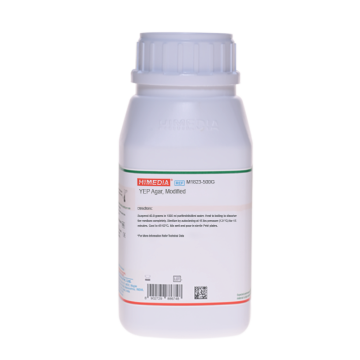 Your enquiry has been submitted
Your enquiry has been submitted
YEM Agar
Intended Use
Recommended for the cultivation of Agrobacterium species and other soil microorganisms.
Composition
| Ingredients | Gms / Litre |
|---|---|
| Yeast extract | 1.000 |
| Mannitol | 10.000 |
| Dipotassium hydrogen phosphate | 0.500 |
| Magnesium sulphate | 0.200 |
| Sodium chloride | 0.100 |
| Agar | 15.000 |
Final pH (at 25°C): 7.0±0.2
**Formula adjusted, standardized to suit performance parameters
Directions
Suspend 26.8 grams in 1000 ml purified / distilled water. Heat to boiling to dissolve the medium completely. Sterilize by autoclaving at 15 lbs pressure (121°C) for 15 minutes. Cool to 45-50°C. Mix well and pour in sterile Petri plates.
Principle And Interpretation
YEM Agar is widely used for the cultivation of Agrobacterium species and other soil microorganisms.
Agrobacterium is a genus of Gram negative bacteria. The Agrobacterium genus is quite heterogenous and is well known for its ability to transfer DNA between itself and plants. Agrobacterium tumefaciens is a ubiquitous soil borne pathogen responsible for Crown Gall disease, affecting many higher species of plant (4). YEM Agar is also used for the cultivation of the symbiotic nitrogen fixing microorganisms like Rhizobium species to make it suitable for the production of legume inoculants.
YEM Agar which contains mannitol as a carbon source and yeast extract as a source of both nitrogen and growth factors for Agrobacteria. It also poises oxidation - reduction potential of medium in the range favourable for Rhizobia and serves as hydrogen donor in respiratory process (1). Mannitol is the fermentable sugar alcohol source. Magnesium provides cations essential for the growth of Agrobacteria.
Type of specimen
Soil samples.
Specimen Collection and Handling
For soil samples, follow appropriate techniques for sample collection, processing as per guidelines and local standards(4). After use, contaminated materials must be sterilized by autoclaving before discarding.
Warning and Precautions
Read the label before opening the container. Wear protective gloves/protective clothing/eye protection/ face protection. Follow good microbiological lab practices while handling specimens and culture. Standard precautions as per established guidelines should be followed while handling specimens. Safety guidelines may be referred in individual safety data sheets.
Limitations
- Some strains may show poor growth due to nutritional variations.
Performance and Evaluation
Performance of the medium is expected when used as per the direction on the label within the expiry period when stored at recommended temperature.
Quality Control
Appearance: Cream to yellow homogeneous free flowing powder
Gelling: Firm, comparable with 1.5% Agar gel
Colour and Clarity of prepared medium: Light amber coloured clear to slightly opalescent gel
Reaction: Reaction of 2.68% w/v aqueous solution at 25°C. pH : 7.0±0.2
pH: 6.80-7.20
Cultural Response
Cultural characteristics observed after an incubation at 25-30°C for upto 5 days.
| Organism | Growth |
|---|---|
| Rhizobium leguminosarum ATCC 10004 | Luxuriant |
| Rhizobium meliloti ATCC 9930 | Luxuriant |
| Agrobacterium tumefaciens ATCC 33970 | Luxuriant |
Storage and Shelf Life
Store between 10-30°C in a tightly closed container and the prepared medium at 20-30°C. Use before expiry date on the label. On opening, product should be properly stored dry, after tightly capping the bottle in order to prevent lump formation due to the hygroscopic nature of the product. Improper storage of the product may lead to lump formation. Store in dry ventilated area protected from extremes of temperature and sources of ignition. Seal the container tightly after use. Product performance is best if used within stated expiry period.
Disposal
User must ensure safe disposal by autoclaving and/or incineration of used or unusable preparations of this product. Follow established laboratory procedures in disposing of infectious materials and material that comes into contact with sample must be decontaminated and disposed of in accordance with current laboratory techniques (2,3).
Reference
- Allen. E.K. and Allen. O.N., 1950, Bacteriol. Rev., 14:273.
- Isenberg, H.D. Clinical Microbiology Procedures Handbook 2nd Edition.
- Jorgensen, J.H., Pfaller , M.A., Carroll, K.C., Funke, G., Landry, M.L., Richter, S.S and Warnock., D.W. (2015) Manual of Clinical Microbiology, 11th Edition. Vol. 1.
- Loper, J. E. and Ishimaru, C. A., in The Rhizosphere and Plant Growth (eds Keister, D. L. and Cregan, P. B.), Kluwer Academic Publishers, 1991, pp. 253–261.
| Product Name | YEM Agar |
|---|---|
| SKU | M1853 |
| Product Type | Regular |
| Physical Form | Powder |
| Origin | Animal Free (Microbial) |
| Packaging type | HDPE |
| References | 1.Allen. E.K. and Allen. O.N., 1950, Bacteriol. Rev., 14:273.2.Loper, J. E. and Ishimaru, C. A., in The Rhizosphere and Plant Growth (eds Keister, D. L. and Cregan, P. B.), KluwerAcademic Publishers, 1991, pp. 253–261. |
| Customized Product Available | No |





